After finally getting the cams this week I was looking forward to getting the rest of this engine assembled over the weekend. Got going bright and early Saturday morning, and of course ran into an immediate problem. After installing the cams in the heads, then the gears on the cams, I started looping the big timing chain around the other gears to finish the timing setup. But after getting the chain positioned correctly, when I tried to put some tension on the chain it didn't seem to be in the right position. One of the things you always want to do with these engines is make sure that all the gears are lined up in the same plane. If the gears are out of line with each other, you end up with side stresses on the chain, which will cause a premature chain failure. When I laid the straight edge on the two cam gears and looked at the fuel pump gear, I saw the worst misalignment I'd ever seen on one of these engines:
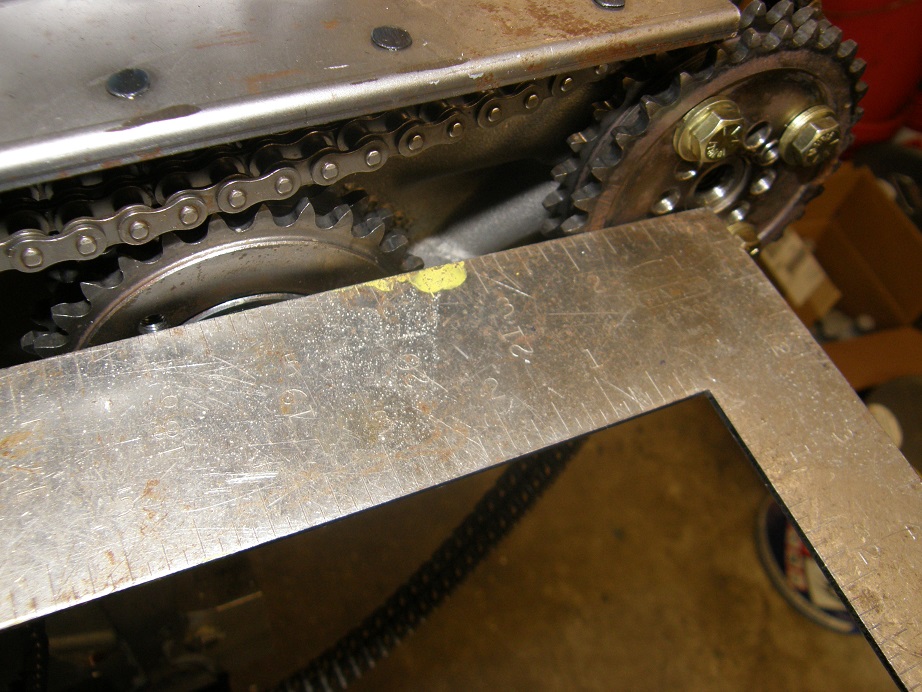
The fuel pump gear is a good 0.200" back from the two cam gears. With that much out of plane deflection it is remarkable to me that the chain even ran for as long as it did. A similar check on the adjuster gear showed that it was out of plane in the opposite direction, forward of the two cam gears, by about 0.100".
Fortunately, this is an easy fix. The gears are pressed onto their bearings, and all that has to be done is to move them by pressing them forward or back into the correct position. Easier said than done, of course, but after several trips back and forth to the press and multiple test fits, I finally got both the fuel pump gear and the adjuster gear positioned correctly. Here's a picture shown the alignment of the fuel pump gear and the cam gear after the correction:
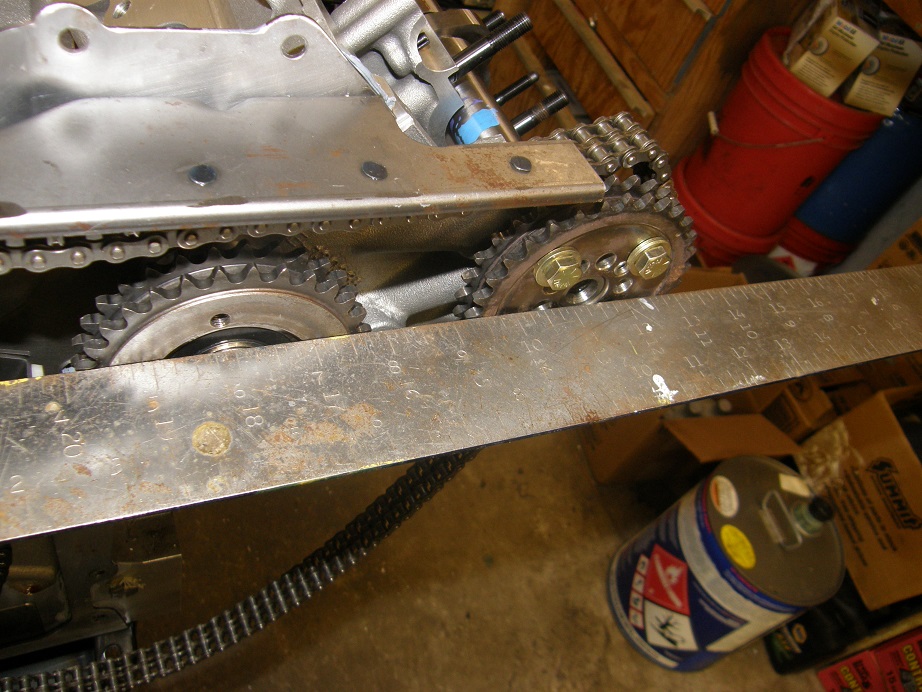
After resolving this issue the rest of the timing setup went together without any trouble. We had already decided to replace the chain, so I assembled the new chain on the gears. After waiting 3 months for the cams it was good to finally see the complete timing setup:
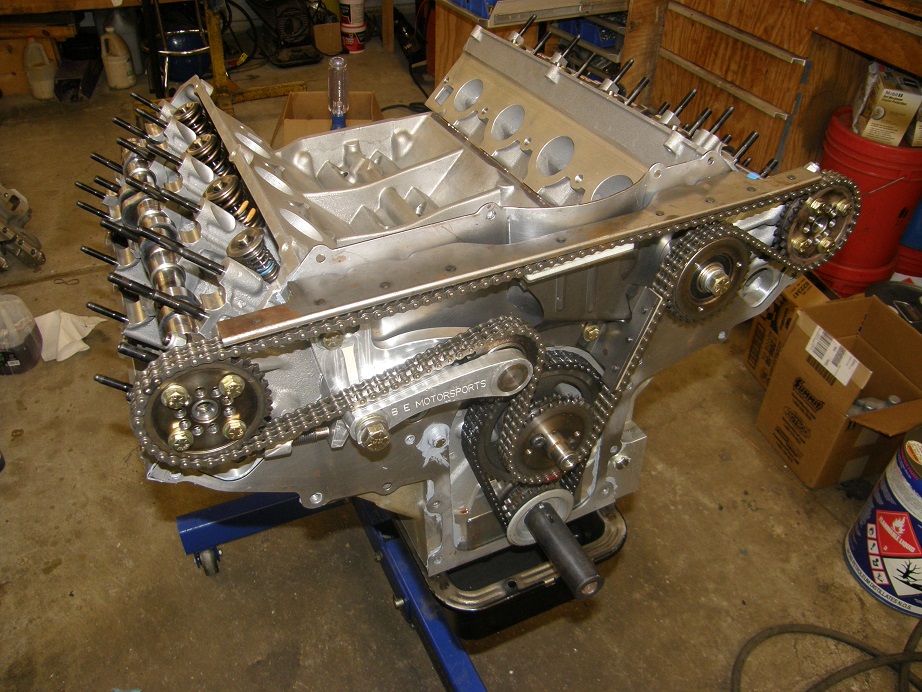
I spent the rest of the day Saturday installing the front cover and the oil pan. The front cover can be challenging in some cases, especially if it is a new cover and has never been fit to the engine before, but since this engine was already together at one point, most of the fitment issues were worked out, and I was happy to see that after installation of all the gaskets, the cover slid neatly into position with no issues. I did have an issue with one of the four bolts that holds the front cover to the backing plate up at the top, but it was just a stripped thread, and since on this particular front cover the holes did not go all the way through the cover at the top, I simply drilled the stripped hole deeper until it did come through, then tapped the drilled portion and put the bolt in. One other odd thing about this cover has to do with the inspection covers that bolt in place on each side. This is the second cover I've seen where the five smaller bolts that hold each inspection cover in place were tapped for fine threads. The stock covers, and most of the aftermarket ones, are tapped with normal coarse threads.
After the front cover was on I flipped the engine over to install the oil pan. I've always liked the view of this engine from underneath:

The oil pan went on without any major issues, at least as much as it can with two gaskets, the windage tray, the long pickup tube and the extended sump LOL. I called it a night on Saturday, fairly pleased with how the engine was going together.
Sunday morning I got the engine flipped back upright and started the tedious job of setting the cam timing. I had checker springs installed on cylinder #1, so I used that cylinder to time the right cam, and also check piston to valve clearance once the timing had been set. I remember earlier in this project Jason had struggled a little with finding top dead center, so I wanted to check that to be sure I knew that it was correct. Jason had installed a timing tape over the degree marks on his harmonic balancer, but I was using a regular degree wheel bolted to the balancer. After installing a piston stop in #1 and finding TDC, it looked like Jason's marks were within a 1/2 degree of where I had found TDC. But then I noticed that the timing pointer on the harmonic balancer, which I had never removed, had been installed upside down. When I unbolted it and flipped it over, it lined up pretty well with the original marks on the harmonic balancer, so I pulled the timing tape off and will refer to the marks on the balancer when timing the engine.
In the meantime I tensioned the chain, and after installing the cams straight up according to the marks, I checked the intake centerline of the right cam and found it to be 3 degrees retarded. I wanted it at about 103, so I loosened the bolts on the right cam gear, pulled the pin, and then repositioned it to get close. Checked it again and it was exactly 103, so I added Loctite to the bolts on the cam gear and tightened them. Here's a picture of the setup in the midst of the cam timing operation:
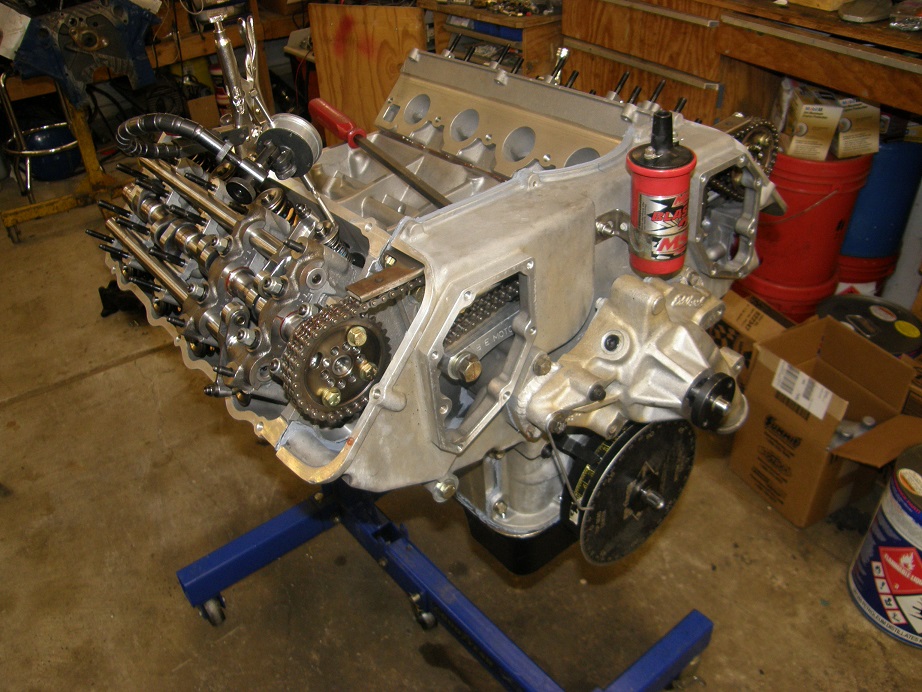
I went through the same procedure on the left cam, and set it at 105 degrees, then disassembled the right side and used my home built on-engine valve spring compressor to pull the checker springs and install the real valve springs on cylinder #1. After that I spent the next hour or so installing the rocker shafts and rocker arms permanently, and then cold lashing the valves. Then, in preparation for the pre-oil I installed the oil filter adapter, the oil filter, and a gauge on top of the oil filter adapter.
Pre-oiling the engine with the valve covers off is really important IMO, especially with these engines. This is where you can confirm that ALL the rockers have oil, prior to the first engine start. It is also a big mess on these engines, because the oil will overflow the heads and puddle under each exhaust rocker on the floor. In preparation for that I had newspaper and paper towels down, to catch any oil that came pouring off the heads. Here's a shot of the engine with my drill on a pre-oiling rod, ready to pre-oil the engine:

I added 8 quarts of oil to the engine, then spun the drill on low speed. I was gratified to see that within 3 or 4 revolutions the drill was being dragged down by the pump. The gauge read 65 psi, and the drill was probably only turning 100 RPM, so the oil pressure was looking good. And sure enough, after 20 seconds or so I started hearing popping indicating air was coming out of the valvetrain, and then oil started pouring out. This is what you want to see when you pre-oil one of these engines:

I checked to make sure that I had oil at all 16 rocker arms, and then stopped the drill. Probably only lost a pint of oil on the floor

With all the valvetrain stuff now out of the way, the remaining work of buttoning up the engine seemed like it ought to be pretty easy. And it was - right up to the intake manifold. I test fit the intake, and the first thing I found was that it was sitting up way too high when the cork pieces were used on the end rails. I like to use the cork pieces on the SOHCs because they fill a large triangular gap at each corner of the intake, but the flat part of the cork was holding the intake off the intake gaskets, and the bolt holes didn't line up. So, I pulled the corks, set the intake in place on the gaskets, and everything seemed to fit fine. So, I glued the gaskets in place with RTV, put a bead of RTV on each end rail, and set the manifold in place. Then, and only then, did I discover that while the bolt holes in the manifold lined up with the heads at the back of the engine, they were misaligned at the front. I made a futile attempt to bolt the intake in place anyway, but the bolts were just not going in. Jason had stripped a bunch of these bolt holes in the head when he put the engine together, and now it was clear to me why. Seemed like the only option was to enlarge or slot the holes in the intake, so that it could be bolted in place properly. Reluctantly I pulled the intake off the engine and spent half an hour cleaning up all the TA-31 that was smeared everywhere. As a result, here is the state of the engine tonight:
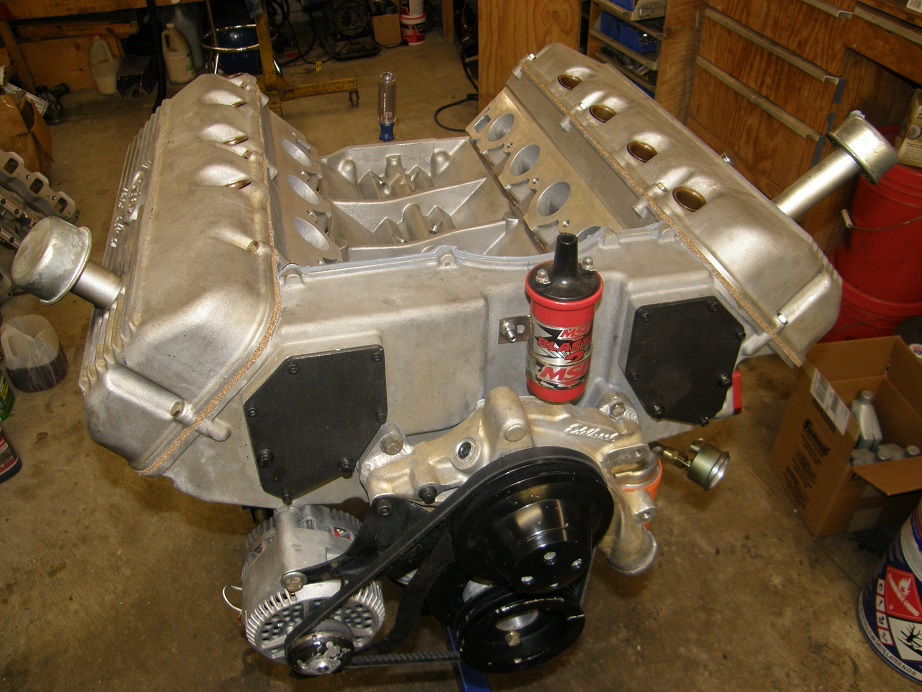
This week I will have to figure out the best solution for the intake dilemma, but once I have the intake bolted onto the engine, it is ready for the dyno. Pretty sure at this point that I will get this engine dynoed next weekend. Stay tuned...